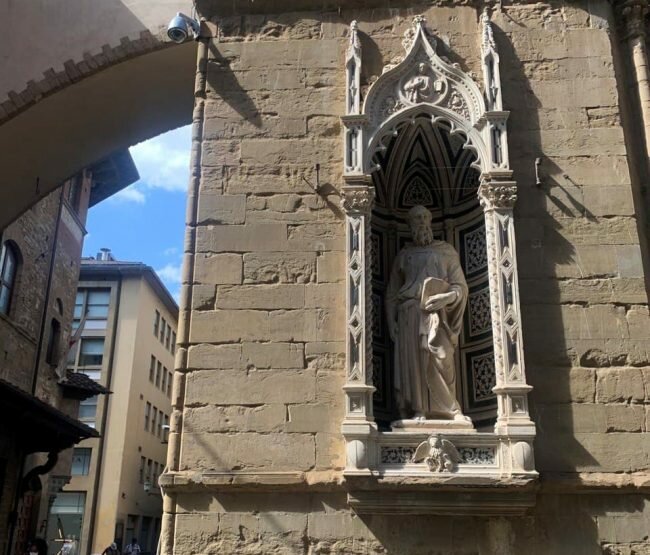Orsanmichele was built in 1337 on the site of the garden (hortus) of the church of San Michele and originally served as an open-arcaded grain market. In 1380 the arcades were filled in and the ground floor converted to a church, while the upper storey was used as an emergency grain store to be drawn on in times of siege or famine.
The new aesthetics
A scheme to decorate the exterior was launched in 1339. Each of the major Florentine guilds was allocated a niche, which was to be filled with a statue of their respective patron saints. The Black Death intervened, so that the first statues were not commissioned until the early 15th century, and they illustrate well the contemporary emergence of the new Renaissance aesthetic.
Also decorating the exterior of the building are 15th-century enamelled terracotta medallions, bearing the heraldic devices (stemme) of the various Florentine guilds, by Luca della Robbia and his workshop.
Donatello’s outstanding St. George, which is hailed as the first truly Renaissance statue, is here represented by
a copy of the marble original, now to be found in the Bargello museum. Near to it, on the north side (in Via San Michele) you’ll admire Nanni di Banco’s great Four Crowned Saints, painted around 1415, with an interesting frieze below illustrating the work of carpenters and masons, whose guild commissioned the work.
The west face is decorated with elaborate Gothic cartwheel tracery and faces the Palazzo dell’Arte della Lana, the Guildhall of the Wool Workers, as might be guessed from the numerous Lamb of God emblems that decorate the facade. This building provides access, by means of an overhead bridge, to the splendid Gothic vaulted grain store above the church. It also houses a small museum (Mon 10am-5pm only; charge), which holds mainly original statuary from the church and is occasionally used for temporary exhibitions.
Inside the church
The odd arrangement of Orsanmichele’s dark interior was dictated by the form of the building. In place of the usual nave flanked by aisles, the central arcade of the original open market divides the church into two parallel naves of equal size. The gloomy interior is somewhat enlivened by frescoed vaults and Gothic stained-glass windows.
The southernmost is dominated by Andrea Orcagna’s huge tabernacle (1339–59), encrusted with coloured glass. In the centre, scarcely visible behind cherubs and votive offerings, is a Madonna by Bernardo Daddi, painted in 1347 to replace one that appeared miraculously on a pillar of the old grain market. The base of the tabernacle is decorated with scenes from the life of the Virgin.


